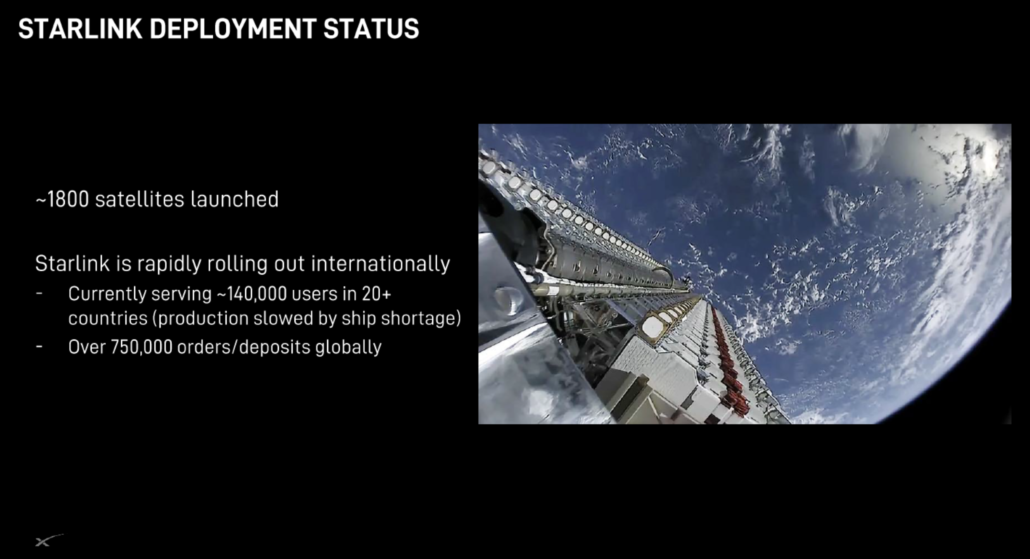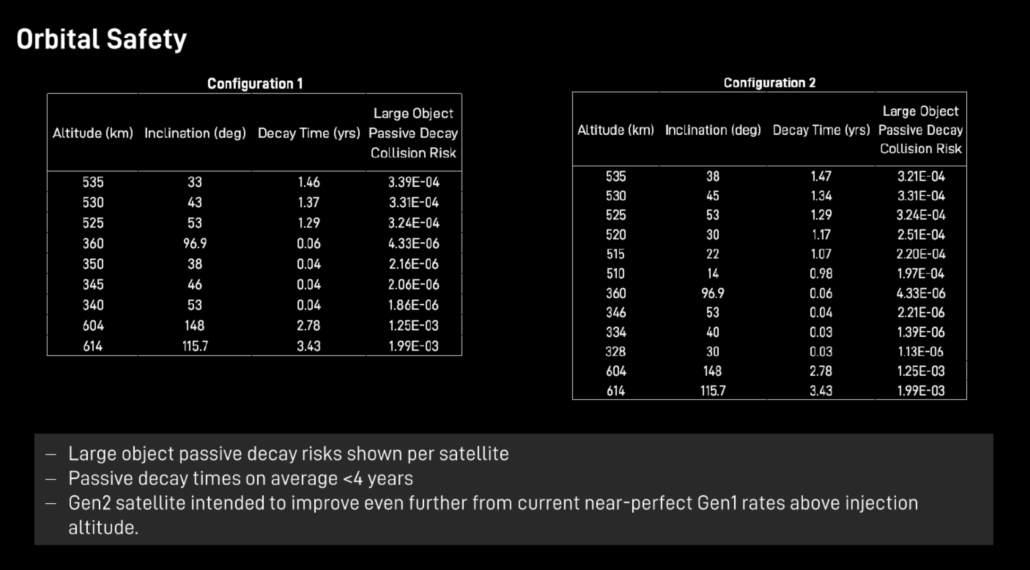
Space exploration Technologies Corporation’s (SpaceX) Starlink satellite internet constellation updated the Federal Communications Commission (FCC) with its deployment statistics earlier this week. In a filing made as part of Starlink’s attempt to modify orbital and launch characteristics of its second-generation (Gen2) satellites, SpaceX revealed that it had launched roughly 1,800 satellites to date in a presentation dated for July this year. Additionally, it also outlined that it is currently serving more than 100,000 users globally and has close to a million pre-orders for a service that plans to put up to 42,000 satellites in low and very low Earth orbit to provide its customers with global satellite-based internet connectivity.
Starlink Asserts Modified Gen2 Plans Will Not Change Key Satellite Interference and Performance Parameters
As part of its modification request, Starlink has submitted two new satellite configurations to the FCC. The first of these is a modification of the original Gen2 request submitted last year, and according to SpaceX, it leverages the company’s Starship launch vehicle system to use more altitudes and planes for evenly spreading out the 30,000 spacecraft.
The second configuration uses SpaceX’s workhorse Falcon 9 to use two additional altitude shells for a total of 12 altitude configurations. Both seek to even out the satellite spread for better coverage, argues Starlink, with the original Gen2 parameters involving only eight altitudes and inclinations to place as many as seven thousand satellites in a single plane.
Both these configurations were present in the brief presentation, including updated Starlink user and pre-order counts. These reveal that Starlink is serving close to 140,000 customers in more than twenty countries and that it has more than three-quarters of a million pre-orders for its equipment. Additionally, it also implies that a production slowdown due to a semiconductor shortage is hampering production.
 The second slide of Starlink’s recent presentation mentions that production has slowed due to a “ship shortage,” in what can be assumed to be a typographical error. Or, the company could also be the victim of a global supply chain slowdown that has seen transport ships await their fate while docked at the port. Image: SpaceX Gen2 Constellation 2021/FCC File Number = SATAMD2021081800105
The second slide of Starlink’s recent presentation mentions that production has slowed due to a “ship shortage,” in what can be assumed to be a typographical error. Or, the company could also be the victim of a global supply chain slowdown that has seen transport ships await their fate while docked at the port. Image: SpaceX Gen2 Constellation 2021/FCC File Number = SATAMD2021081800105
Both the satellite configurations proposed by Starlink will use new satellites, which the service promises will improve its connectivity. According to the SpaceX subsidiary, these satellites will serve more people at faster speeds with lower latency and improved backhaul capabilities. Latency is a crucial metric for Starlink because of the superior performance offered and because it has to demonstrate to the FCC that it can meet the requirements of a government-funded program to bring internet coverage to be remote and rural Americans.
Starship also makes a brief appearance, as SpaceX argues the spacecraft will enable it to deploy satellites faster and at altitudes low enough to reduce the risk of orbital debris. Curiously though, the newer two configurations will place lesser satellites at lower altitudes, but they will spread them out over a larger number of orbital planes.
The original Gen2 application planned to place more than 25,000 satellites at altitudes lower than 400 kilometers in 54 planes. In comparison, the new configuration designed for launch with Starship aims to place roughly 20,000 satellites at the lower altitudes but in 174 planes. It compensates for this by adding two new altitudes with 84 planes.
 Starlink Gen2 orbital collision and decay times. Image: SpaceX Gen2 Constellation 2021/FCC File Number = SATAMD2021081800105
Starlink Gen2 orbital collision and decay times. Image: SpaceX Gen2 Constellation 2021/FCC File Number = SATAMD2021081800105
Starlink’s application narrative for Gen2 also mentioned that the new spacecraft are larger and generate more power over the currently orbiting spacecraft. Additionally, the company was eager to mention that since nearly all of them will fly at altitudes lower than 600 kilometers, astronomers wishing to view the night sky will have to deal with less reflectivity. This has been a concern for space gazers worldwide who have seen their view of the night sky often permeated with the satellites.
The modification has received strong criticism from Starlink’s rivals, who allege that the two configurations violate FCC rules and prove burdensome for the Commission. Leading the criticism is Amazon, who, through its Kuiper subsidiary, has alleged to the body that SpaceX is above accountability, arguing that “[I]f the FCC regulated hypocrisy, SpaceX would be keeping the Commission very busy.”
In response, SpaceX’s director of satellite policy, Mr. David Goldman, has pointed at Amazon’s lack of development of its own satellite constellation, retorting that:
But while Amazon has filed nothing with the Commission to address these conditions on its own license for nearly 400 days, it took only 4 days to object to SpaceX’s next-generation NGSO system.
As it launches more satellites, Starlink appears to be on track to introduce new user dishes and WiFi routers to its American customers. Both of these are designed differently than their predecessors, and according to details on the internet service’s website, the router features several improvements over the one in service right now. These include water resistance and more bandwidth; however, without an ethernet port.
The post Starlink Says Ship Shortage Hurting Production For 750,000 Preorders by Ramish Zafar appeared first on Wccftech.




